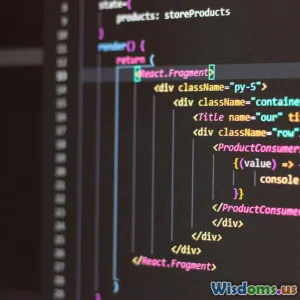
Continuous Integration or Continuous Deployment Which Comes First
9 min read Explore the essential sequence of Continuous Integration and Continuous Deployment and learn which practice developers should adopt first for optimal software delivery. (0 Reviews)
Continuous Integration or Continuous Deployment: Which Comes First?
In today’s fast-paced software environment, organizations strive to deliver high-quality software rapidly and reliably. This urgency has led to widespread adoption of practices such as Continuous Integration (CI) and Continuous Deployment (CD). But despite their popularity, many developers and teams wrestle with the question: Which comes first, CI or CD? This article dives deep to untangle their relationship, offers practical guidance, and explains why understanding the right order can make or break your development pipeline.
What Are Continuous Integration and Continuous Deployment?
Before we decide the order, it’s crucial to understand exactly what CI and CD are.
Continuous Integration (CI)
Continuous Integration refers to the process where developers frequently commit code changes to a shared repository, multiple times a day. Each commit triggers automated builds and tests to detect integration errors early.
Origins of CI trace back to practices championed in Extreme Programming (XP), with the goal of minimizing integration problems and streamlining development workflows.
Benefits of CI include:
- Early bug detection leading to easier fixes
- Reduced integration conflicts
- Faster feedback loops for developers
- Improved code quality
For example, at mobile giant Spotify, developers push code several times daily with automated checks, enabling seamless team collaboration and consistent builds.
Continuous Deployment (CD)
Continuous Deployment extends the automation beyond integration and testing. Here, changes that pass tests are automatically deployed to production without manual intervention.
CD is the ultimate automation goal—it enables rapid delivery and real user feedback. Some organizations use “Continuous Delivery” interchangeably with CD, but the latter specifically implies automatic deployments.
Key benefits include:
- Faster release cycles
- Reduced manual errors
- Immediate user access to new features
- Enhanced responsiveness to market changes
Amazon reportedly deploys new code every 11.7 seconds, showcasing the power of mature CD pipelines.
Which Should Come First: Continuous Integration or Continuous Deployment?
The question is less about which is more important and more about which foundation makes sense to build first?
The short answer: Continuous Integration should come first. Followed by Continuous Deployment.
Why CI Comes First
CI ensures the backbone for safe automation—reliable builds and thorough automated tests. Without this fundamental step, deploying code directly risks introducing bugs and breaking production.
Here’s why CI is the logical initial step:
-
Stabilizes Code Quality Early: CI identifies issues quickly. It’s a must to build confidence before pushing to production automatically.
-
Creates Trust in Automation: Automated testing around CI helps teams trust that code changes won’t break the build or features.
-
Foundation for Faster Feedback: Developers get near-instant feedback, reducing integration complexities.
Consider Facebook, which incorporated CI rigorously before automating deployments. This approach minimized regression and builds confidence in more advanced release strategies.
Building on CI with CD
Once CI pipelines are robust and delivery processes are dependable, teams can introduce CD. CD relies heavily on a stable CI foundation because only well-tested, integrated codes can safely be pushed to users continuously.
-
Automated Deployments Without Quality Sacrifice: Thanks to CI, CD can assume that builds passing tests are production-ready.
-
Reduced Risk and Immediate Rollbacks: Mature CD pipelines add fail-safes and rollback mechanisms.
-
Enables Faster Time-to-Market: Product teams can respond quickly to user needs or critical fixes.
At Netflix, for example, extensive testing and integration are done via CI before code is automatically deployed multiple times a day via CD pipelines, ensuring a smooth viewer experience.
Practical Roadmap: Implementing CI then CD
- Start with Version Control: Use Git or similar tools; every commit should trigger your CI pipeline.
- Automate Builds and Unit Tests: Ensure every commit compiles correctly and passes all unit tests.
- Add Integration and Functional Tests: Increase test coverage to simulate real-world usage.
- Establish Code Quality Gates: Utilize static analysis and peer reviews.
- Only after solid CI, automate Deployments: Start with staging environments, then production with monitoring and rollback strategies.
Real-World Success Stories: The CI-First Approach
Etsy's Deployment Revolution
In the early 2000s, Etsy struggled with deployments causing site outages. They adopted CI practices focusing on integrating and testing code frequently. After stabilizing their CI process, they moved to frequent, automated deployments (CD). Result? Their deployments increased from twice a week to multiple times a day, with near-zero downtime.
Shopify’s Pipeline Evolution
Shopify built their delivery pipeline starting with extensive CI automation, including parallel testing and code validation. Once CI was rock solid, they layered on CD, enabling daily deployment of hundreds of microservices. This approach supported rapid scaling and feature release without sacrificing stability.
Common Pitfalls in Jumping to CD without CI
Some organizations attempt to leap directly into Continuous Deployment, lured by promises of speed. However, skipping or underemphasizing CI leads to problems:
- Frequent Breakages in Production: Without reliable CI, bugs slip through.
- Loss of Developer Confidence: Teams become wary of deploying frequently.
- Increased Downtime and Rollbacks: Manual fixes negate the benefits of automation.
Even tech giants warn against rushing to CD before mastering CI fundamentals. Quality assurance must precede deployment automation.
Conclusion: The Right Sequence Unlocks Value
Continuous Integration and Continuous Deployment are pivotal practices for modern software development. However, the foundation always starts with CI—establishing reliable code integration, rigorous automated testing, and a steady release-ready baseline.
Once CI is fully operational and mature, introducing CD exponentially enhances deployment speed, efficiency, and quality, allowing teams to innovate rapidly and safely.
Adopting this sequence enables businesses to:
- Prevent costly bugs early
- Build developer confidence in automation
- Respond swiftly to market demands
In your journey, prioritize strong CI pipelines before embracing the power and promise of Continuous Deployment. This thoughtful progression ensures your software delivery is a competitive advantage rather than a risky gamble.
References:
- Jez Humble, Dave Farley, Continuous Delivery: Reliable Software Releases through Build, Test, and Deployment Automation
- Nicole Forsgren, Gene Kim, and Jez Humble, Accelerate: The Science of Lean Software and DevOps
- Etsy Tech Blog: https://codeascraft.com/
- Netflix Tech Blog: https://netflixtechblog.com/
- Shopify Engineering Blog: https://engineering.shopify.com/
By understanding and prioritizing Continuous Integration first, and layering on Continuous Deployment next, your software delivery pipeline can achieve speed, stability, and success.
Rate the Post
User Reviews
Popular Posts




















